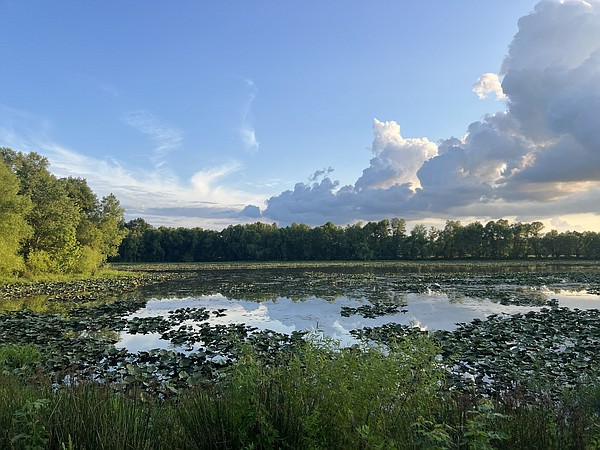Fayetteville wetlands restoration project working to spread conservation awareness
Ainsley Platt
FAYETTEVILLE -- A hoop house lies at the end of a rocky road, surrounded by trees and grasses. The droning of crickets permeates the air. The only sign that the Watershed Conservation Resource Center's property – which will eventually become the River Commons and Institute -- is just outside rapidly growing Fayetteville is the faint sound of cars in the distance.
But here, off a quiet road around four and a half miles from Razorback Stadium, is a remarkable testament to the power of conservation, with eventual goals of expanding public awareness and education on all kinds of conservation topics.
The Arkansas Democrat-Gazette had the opportunity to learn more about the Watershed Conservation Resource Center's conservation efforts as part of an evening tour given last week to attendees of the Arkansas Agriculture, Forestry and Water Conference in Fayetteville of the site of the future River Commons and Institute.
The River Commons and Institute is the end goal of the property, which was purchased jointly by the Watershed Conservation Resources Center and the City of Fayetteville in 2019, with the idea of restoring and protecting the surrounding natural area, creating a permanent home base for the WCRC's restoration projects in the region and hosting public access to the surrounding nature for recreation and educational purposes.
The goal, according to a poster created by the WCRC, is "creating a place where people can connect to the environment, cultural diversity, outdoor recreation, and each other through the site's riverine landscape and training center."
Eventually, this will mean construction of an education center, a boathouse, visitor center, and different types of gardens.
As one of the WCRC's staff led a group along a dirt peninsula to a point at the center of the wetlands, Sandi Formica, the executive director of the WCRC answered questions, provided context and pointed out features of the surrounding wetlands.
But the 25 acres of wetlands weren't always wetlands – originally, the area was excavated for topsoil in the early 2000s.
"The whole idea is we want people to visit this place, and feel like when they walk away, that they're going to conserve, they're going to learn something about ecology, and they're going to do all kinds of recreation, but they're going to also think, 'Oh, wow, in my everyday life, I need to protect the environment,'" Formica said during the tour.
Eventually, the property will be open to the public, Formica said -- but currently the WCRC doesn't have the staff to do that.
The original plan for the area, Formica told those gathered, was to turn the area into residences. She said that due to the historic flooding issues on the property, WCRC had likely saved many prospective property owners from the difficulties associated with dealing with floods.
The small wetland area is popular with birders, Formica said, who have helped the WCRC track the many bird species that visit the property – many of which are rare species. In total, over 100 species have been cataloged, she said.
Birds aren't the only creatures to be found in the wetlands here – beavers have built a lodge at one end, and otters had been spotted at times – although not in a while, Formica said.
"We love them here," Formica said of the beavers. She said she'd like to see more of them, but that the beavers that are already there likely wouldn't allow others to encroach on their territory.
The water in the wetlands here are turbid, Formica said – something she originally didn't like. But because of the turbidity, many of the invasive species that plague the region's waterways haven't gotten a foothold here, she said.
"Aquatic invasives that you see, like at Lake Leatherwood in Eureka Springs and in Lake Bentonville, they like clear water," Formica said. "They won't come in here. We don't have them, so that is actually a good thing, and so we're not that anxious to necessarily resolve that issue."
Some of the turbidity is as a result of wind stirring up the water, Formica said, so they plan to add more wetland islands to break up the wind.
Formica later brought attendees to the top of a mound – formed from some of the excavated topsoil from that 2000s project. She explained that education and engagement with the natural world was also crucial to building support in the community for conservation and environmental protection.
"We had some second-graders looking at riparian restoration -- stream restoration," Formica said. "We had them for like, I don't know, 30 minutes, and they were great, they were milling around, listening to us, and then they saw a turtle in the water. Oh my gosh -- totally transformed. I mean, these kids were excited, and then at the end of the class we said 'Well, what did you guys like best today?' And everybody said the turtle."
"We realized if we want environmental protection, we need to get more involved with the animals too, and showing them to people and kids," Formica continued.
She pointed out a stand of river cane, on the property across the street that could be seen from the top of the mound. River cane, she said, used to be abundant in Northwest Arkansas and it a culturally significant plant for Native tribes. She said the WCRC has been working with river cane experts as part of its conservation efforts.
"Part of our mission is to change people's attitudes about river cane, because most people think it's invasive, and they want to destroy is, and lots of landowners still destroy it," Formica said. "The cane is very important to Native Americans as a cultural resource, and this is is the hard part -- it takes years before you have a stand of cane that's the right size for cultural resource purposes."

en
2024-07-21T17:39:00.0000000Z
2024-07-21T17:39:00.0000000Z
https://www.arkansasonline.com/news/2024/jul/21/fayetteville-wetlands-restoration-project-working/